Hyposmotic Study guides, Class notes & Summaries
Looking for the best study guides, study notes and summaries about Hyposmotic? On this page you'll find 10 study documents about Hyposmotic.
All 10 results
Sort by

-
Animal Physiology Exam Questions with 100% Correct Answers
- Exam (elaborations) • 26 pages • 2024
-
Available in package deal
-
- $16.49
- + learn more
What are the 2 fluid compartments of the body? What 2 sub-types of the second compartment is there? - ANSWER-1. intracellular fluids 2. extracellular fluids (interstitial fluid, blood plasma) Describe the composition of body fluid (3). (point 2 has 3 sub-points) - ANSWER-- water - large molecules -> carbohydrates: sugars -> proteins: enzymes -> fats: fatty acids - electrolytes: inorganic ions and salts What are the 3 types of regulation of blood plasma? - ANSWER-- osmotic re...

-
Creighton University Bio 201 Unit 2 Test review Questions With 100% Correct Answers.
- Exam (elaborations) • 10 pages • 2024
- Available in package deal
-
- $9.69
- + learn more
What is Fick's Law? What influences diffusion - Answer-The molar flux due to diffusion is proportional to the concentration gradient F=kA((c1-c2)/d)) - Answer-F is rate of diffusion K is diffusion constant A is surface area for diffusion D id distance for diffusion (ex: membrane thickness) C1-C2 is difference in concentration How does the diffusion of uncharged and charged particles differ? - Answer-Uncharged particles diffuse irrespective of the concentration of each other. Charged par...
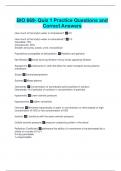
-
BIO 669- Quiz 1 Practice Questions and Correct Answers
- Exam (elaborations) • 12 pages • 2024
-
Available in package deal
-
- $9.99
- + learn more
How much of the body's water is intracellular? 2/3 How much of the body's water is extracellular? 1/3 Interstitial: 75% Intravascular: 25% Smaller amountsL sweat, urine, transcellular Populations susceptible to dehydration: Pediatric and geriatric Net filtration forces favoring filtration minus forces opposing filtration Aquaporins small pores in cells that allow for water transport across plasma membrane Solute Electrolytes/proteins Solvent Water/plasms Osmolarity Concentration of osmo...
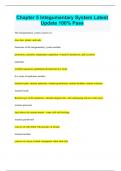
-
Chapter 5 Integumentary System Latest Update 100% Pass
- Exam (elaborations) • 5 pages • 2024
- Available in package deal
-
- $8.99
- + learn more
Chapter 5 Integumentary System Latest Update 100% Pass The integumentary system consists of... skin, hair, glands, and nails Functions of the integumentary system include: protection, sensation, temperature regulation, vitamin D production, and excretion epidermis stratified squamous epithelium divided into five strata five strata of epidermis include: stratum basale, stratum spinosum, stratum granulosum, stratum lucidum, stratum corneum stratum basale Bottom layer of the epidermis. cuboida...

-
BIO 669- Quiz 1 Study Questions with Correct Answers 100% Verified and Graded A+
- Exam (elaborations) • 12 pages • 2024
-
Available in package deal
-
- $9.79
- + learn more
BIO 669- Quiz 1 Study Questions with Correct Answers 100% Verified and Graded A+ How much of the body's water is intracellular? - Correct Answer 2/3 How much of the body's water is extracellular? - Correct Answer 1/3 Interstitial: 75% Intravascular: 25% Smaller amountsL sweat, urine, transcellular Populations susceptible to dehydration: - Correct Answer Pediatric and geriatric Net filtration - Correct Answer forces favoring filtration minus forces opposing filtration Aquaporin...
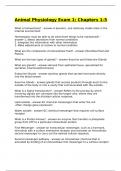
-
Animal Physiology Exam 1: Chapters 1-5
- Exam (elaborations) • 11 pages • 2024
-
- $10.99
- + learn more
What are the components of extracellular fluid? - answer-Interstitial fluid and Plasma What are the two types of glands? - answer-Exocrine and Endocrine Glands What are glands? - answer-derived from epithelial tissue, specialized for secretion (chemicals/hormones) Endocrine Glands - answer-ductless glands that secrete hormones directly into the blood stream Exocrine Glands - answer-glands that secrete products through ducts to the outside of the body or into a cavity that communicate...
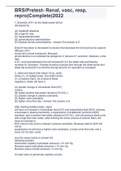
-
BRS/Pretest- Renal, vasc, resp, repro(Complete)2022
- Exam (elaborations) • 27 pages • 2022
-
- $17.99
- + learn more
1. Secretion of K+ by the distal tubule will be decreased by (A) metabolic alkalosis (B) a high-K+ diet (C) hyperaldosteronism (D) spironolactone administration (E) thiazide diuretic administration The answer is D Distal K+secretion is decreased by factors that decrease the driving force for passive diffusion of K+ across the luminal membrane. Because spironolactone is an aldosterone antagonist, it reduces K+ secretion. Alkalosis, a diet high in K+, and hyperaldosteronism all incr...

-
Understanding Patho: Quiz 1 - Electrolytes & Immunity - Exam 1 Questions With Verified Answers
- Exam (elaborations) • 44 pages • 2024
-
- $13.49
- + learn more
Understanding Patho: Quiz 1 - Electrolytes & Immunity - Exam 1 Questions With Verified Answers What makes up approximately _______ percent of lean body weight in men? women? - answermen = 60%. women = 50%. what fraction of water is in the intracellular space? extracellular space? - answerintracellular = two-thirds. extracellular = one-third. Is the ICF or ECF subdivided into more categories? what are these? - answerECF. Into intravascular and interstitial. What percentage of the ECF ...
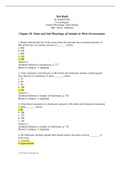
-
Chapter 28: Water and Salt Physiology of Animals in Their Environments Hill • Wyse • Anderson
- Exam (elaborations) • 20 pages • 2022
-
- $9.49
- + learn more
1. Marine teleosts that live in the ocean where the seawater has an osmotic pressure of 800 mOsm have an osmotic pressure of _______ mOsm. a. 900 b. 850 c. 800 d. 600 e. 500 Answer: e Textbook Reference: Introduction, p. 717 Bloom’s Category: 3. Applying 2. If the osmolarity of freshwater is 100 mOsm, the freshwater animals would regulate their blood to an osmolarity of about _______ mOsm. a. 70 b. 80 c. 90 d. 100 e. 120 Answer: e Textbook Reference: Animals in Freshwater, p....
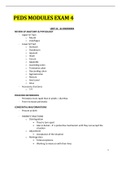
-
NURSING 1310 - PEDS MODULES EXAM 4.
- Exam (elaborations) • 98 pages • 2021
-
- $10.99
- + learn more
PEDS MODULES EXAM 4 UNIT 11: GI DISORDERS REVIEW OF ANATOMY & PHYSIOLOGY • Upper GI Tract o Mouth o esophagus • Lower GI Tract o Stomach o Duodenum o Jejunum o Ileum o Cecum o Appendix o Ascending colon o Transverse colon o Descending colon o Sigmoid colon o Rectum o Anal canal o Anus • Accessory structures o ??? PEDIATRIC DIFFERENCES • Peristalsis more rapid than in adults = diarrhea • Fever increases peristalsis CONGENITAL MALFORMATIONS • Present at...

How much did you already spend on Stuvia? Imagine there are plenty more of you out there paying for study notes, but this time YOU are the seller. Ka-ching! Discover all about earning on Stuvia


